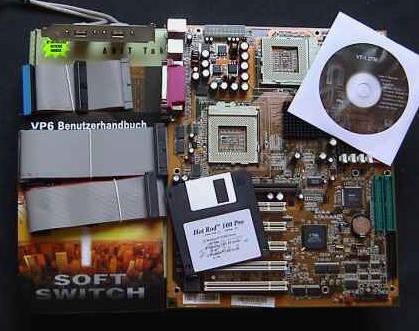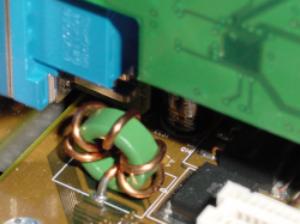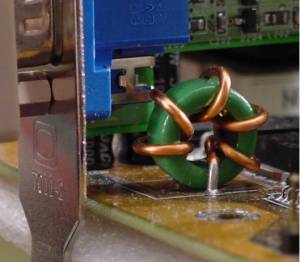|

The Bundle

Here's what's included: The motherboard itself, a paper copy of the
manual; a CD with drivers, manuals, and other extras; a floppy disk with
drivers for the HighPoint 370 IDE controller; a floppy drive cable; two
UDMA100 cables; one bracket with two extra USB connectors. My VP6 came
with a German manual, but the CD includes .pdf files of the manual in five
different languages. It took some exploration to find the English manual
there, as the CD's menus are all in Chinese. However, once I found it I
was very pleased with its quality of English and attention to detail.
One more thing about the CD: Once you get your system up and running, be
sure to check out the little video ABIT has included here. It features
their goofball mascot surfing around amidst outer-space explosions and
overseeing motherboard production in a Batcave-like secret lair. It's
hilarious.
Layout:
The basic specifications are:
| CPU Type |
Dual Socket 370 (Pentium III only) |
| Chipset |
VIA 694X-MP, 686B |
| AGP |
1X/2X/4X |
| PCI/ISA |
5/0 |
| FSB |
100/133 |
| USB |
2 + 2 (with header) |
| DIMMs |
4 |
| Form Factor |
ATX |
| Dimensions |
245 x 305 cm |
| ATA support |
33/66/100 x 4 |
| Hardware Monitoring |
VIA Hardware Monitor |
| Extras |
HighPoint370 ATA100/RAID controller, ABIT SoftMenu
III |
The 370-pin sockets are set at 90° angles to one another on the
north-west corner; this makes them less easy to access when installed in a
case than the BP6's sockets were, but in exchange we get a much more
favorable location for the power connector. There is no excuse for putting
the power connector anywhere else besides the very north edge; fortunately
that is exactly where ABIT have been putting it on all their recent boards.
There is ample space for large cooling systems around both sockets. This
had been a consideration with the BP6: many of us had to file away
sections of our golden orbs to make them fit in amongst the poorly-placed
capacitors. Now all those transistors and capacitors are tucked nicely
away in the corner.
There is one important consideration here: some the filter capacitors
around the bases of the sockets lay dangerously close to the fan clips. As
other reviewers have noted, if you go fumbling around in your case with a
screwdriver trying to pry off the fans, you may just knock one of these
filter capacitors off. Take special care when attaching or removing them.
4 DIMM slots support up to 2GB of SDRAM. I had no problem mixing and
matching all different kinds of memory on all four slots, but note that
the DIMMs are counted one through four from the outside in, not vice-versa,
as one would expect. In the past, ABIT has always included TI data buffers
on their 4 DIMM models (BX6 and KA7). But in those cases, 4 DIMMs were
more than the chipsets' official capacities. The 694X chipset officially
supports eight banks of SDRAM, and it is good to see that ABIT has made
use of that capability.
There number of PCI slots is limited to five due to the presence of the
HighPoint 370 controller chip. It provides ATA/100 support and RAID
capabilities, but takes up an IRQ. There are four IDE ports for up to 8
IDE devices. The two native ports are aqua-blue, while those that use the
HighPoint controller are orange. Even the blue ports support ATA/100
thanks to the VIA 686B south bridge. There is no ISA slot. This may
disappoint some, but I personally welcome the phasing out of ISA devices.
On the south-east corner, you'll find the PN1 and PN2 headers, a third fan
header, and the little red light that informs you when the board is
powered up. The VP6 has no integrated VGA, and no onboard sound.
I had only one major concern about the board's layout: that's the
proximity of the L16 inductor coil to the bracket of the AGP card. The two
were a little too close for comfort, and I was a little worried that, were
my card not securely fastened, they might come into contact and cause a
short. I bent the coil a little bit to the south just to be safe.
|

|
|

|
Copyright
liegt bei All-About-PC. Alle Rechte vorbehalten.
Alle Information auf dieser Website durch All-About-PC
urheberrechtlich geschützt. Reproduktion und Vertrieb in jeglicher
Form ohne Zustimmung der Redaktion sind verboten.
Wiewohl alle Informationen auf dieser Website streng recherchiert
und weitestgehend durch Sekundärquellen gegengeprüft und bestätigt
werden, kann für den Inhalt und daraus etwaig entstehenden Schaden
keine Verantwortung übernommen werden. |
|




